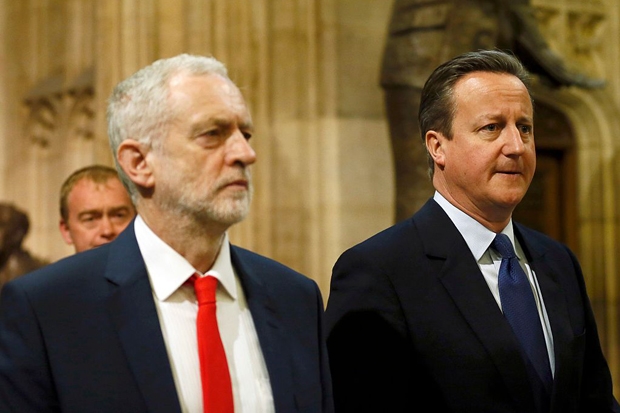On the eve of last year’s general election result, many pundits predicted the demise of Britain’s two-party system. The likeliest outcome was another hung parliament in which one of the smaller parties — the Lib Dems or the SNP — held the balance of power. These same pundits pointed to the steady decline in membership of the two main parties, as well as the success of insurgent parties in the European and regional elections, as evidence of this sea change.
In the event, the pundits were ridiculed for getting it wrong. Yet is it possible they were just a year too early? The surprise Brexit win in yesterday’s EU referendum looks like it may bring about some kind of political realignment.
First, let’s deal with the impact of the Brexit victory on Labour which, it’s now clear, will be worse than on the Conservatives. More than half of Labour voters have turned out to be committed Eurosceptics. In Labour’s heartlands outside London, turnouts were at record highs – with Leave beating Remain 70:30 in areas like Stoke-on-Trent, Tristram Hunt’s constituency. But unlike their Tory counterparts, the Labour Outers had no one at the top of their party to speak for them. In addition, nearly every Labour MP campaigned for Stronger In during the referendum. When you bear in mind that the vast majority of Labour’s Eurosceptic voters are C2DEs, a demographic the party has been struggling to hang on to for the last 50 years, the consequences of this result could be disastrous – one reason Jeremy Corbyn is under pressure today, with the Parliamentary Labour Party likely to table a vote of no confidence next week.
Traditionally, the Labour Party has been an alliance between middle class liberals – the fruit-juice drinkers, nudists, sandal-wearers, sex-maniacs, Quakers, ‘Nature Cure’ quacks, pacifists and feminists identified by George Orwell in the Road to Wigan Pier – and working class traditionalists. And one of the great themes of British politics in the post-war period has been the gradual collapse of that coalition. In 1966, 69 per cent of manual workers gave their vote to Labour; by 1987 it was only 45 per cent. If you compare the 2005 and 2015 election results, support for Labour among ABC1 voters barely changed, but among C2 voters it fell from 40 per cent to 30 per cent and among DE voters from 48 per cent to 37 per cent.
Interestingly, Corbyn’s election as leader has done little to alienate Labour’s more affluent supporters. In the local elections last month, the party did well in London, Swindon, Milton Keynes, Reading and Crawley, but fared badly in its working class heartlands. In the north, for instance, its vote declined by 1.8 per cent compared to the 2015 general election. Not surprisingly, Labour’s C2DE voters are unimpressed by a leader who refuses to sing the National Anthem, wants to return the Falklands to Argentina and is weak on defence and security. That same demographic is likely to feel even more at odds with the Labour Party following its almost unanimous support for Remain.
So where will these voters go? In Wales, where Leave triumphed by 51.7 per cent to 48.3 per cent, some will drift off to the nationalists, following in the footsteps of their Scottish counterparts, and in some parts of England (seaside towns, South Yorkshire, Derbyshire) they may join the exodus to UKIP. But many of them will end up politically homeless and that creates an opportunity for the Eurosceptic wing of the Conservative Party. One of the oddities of the referendum campaign was the emergence of a centre-right anti-Establishment alliance between a middle class, educated elite (Boris Johnson, Michael Gove, Priti Patel, Chris Grayling, Andrea Leadsom, Liam Fox) and C2DEs. Could this alliance survive?
It now looks more likely than not that the Tory Party will be led by a Eurosceptic in three months’ time, probably Boris or Gove. (Although I wouldn’t write off Theresa May.) If that happens, will the new leader try and preserve this radical alliance? Writing ahead of the referendum in The Times this week, Danny Finkelstein claimed that, should Brexit win, the architects of the Vote Leave campaign wouldn’t be able to detach themselves from the manual workers who’ve handed them victory, whether they want to or not. ‘You gotta dance with the one that brung ya,’ he wrote, quoting a political aphorism of Ronald Reagan’s. His view is that this will be the undoing of Boris, Gove, et al, because they won’t be able to deliver what these voters want, which he summarised as follows:
They are hoping for greater protection from the social and economic change brought by globalisation. They seek more work, better-funded public services, less power to corporations and the elite and, above all, less of the immigration that they believe puts pressure on their wages and communities.
Finkelstein’s thinks this is a problem because if we leave the EU we’ll have to leave the single market and that, in turn, will mean we can only attract foreign businesses and investors by cutting taxes on high-earners, paying lower wages to unskilled workers and encouraging large numbers of migrants to come and work here. You see his point.
But I don’t share Finkelstein’s pessimism about the brave new world we’ll find ourselves in post-Brexit. More likely we’ll end up with some kind of associate membership of the EU, with privileged access to the single market but without freedom of movement. I don’t see how the EU can survive this cataclysmic shock without creating a different type of membership for those EU states that don’t want to be part of the Eurozone – if they hang tough, Britain’s referendum result will produce a stampede for the exit door. In which case, becoming a North Sea version of Singapore won’t be necessary.
Of course, a coalition between Tory Eursoceptics and C2DE Labour defectors would be problematic for other reasons – different attitudes to austerity, for instance. Could the new leader of the Conservatives keep these strange bedfellows happy while, at the same time, sticking to George Osborne’s deficit-reduction targets? That would be a challenge, particularly with Farage and co sitting on the party’s right flank flashing their knickers at them.
But the new leader would probably need to hang on to these voters because the losing side in the referendum campaign might want to preserve its own coalition. This morning, as the full import of what had just happened began to sink in, the historian Simon Schama made the following plea on Twitter: ‘There has to be a political place to go for the 48% which is not the broken Tory party or the enfeebled Labour Party. The fight starts now.’
All this makes Tim Montgomerie’s piece in 2013 about a potential re-alignment of British politics look extremely prescient. He imagined a new political order consisting of four new parties: the Eurosceptic one I’ve described above (Nationals), a Simon Schama grouping combining the metropolitan wing of the Tories with the rump of New Labour (Liberals), a libertarian consortium (Freedom) and a left-wing party like Podemos in Spain (Solidarity).
‘I’m not sure if they would win many elections,’ Montgomerie said of the Nationals, ‘or even many votes.’ I beg to differ. Judging from how well Vote Leave has done in this referendum, a new political grouping that re-assembled Labour’s coalition between middle-class intellectuals and manual workers could sweep all before it. But it would take a political genius to hold it together.







Comments